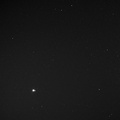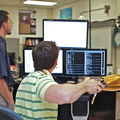
WIKIARCHIVES.SPACE
The Human Spaceflight Archive

In the lower left portion of this image, the Earth can be seen, as well as the much smaller Moon to Earth's right. When MESSENGER took this image, a distance of 183 million kilometers (114 million miles) separated the spacecraft and Earth. To provide context for this distance, the average separation between the Earth and the Sun is about 150 million kilometers (93 million miles). Though it is a beautiful, thought-provoking picture, viewing our planet from far away was not the main reason that the mission team planned the collection of this image. Instead, this image was acquired as part of MESSENGER's campaign to search for vulcanoids, small rocky objects that have been postulated to exist in orbits between Mercury and the Sun. Though no vulcanoids have yet been detected, the MESSENGER spacecraft is in a unique position to look for smaller and fainter vulcanoids than has ever before been possible. MESSENGER's vulcanoid searches occur near perihelion passages, when the spacecraft's orbit brings it closest to the Sun. Today is another such perihelion, and MESSENGER is taking a new set of images to search for tiny asteroids lurking close to the Sun.
Information
- Taken in
- Space
- Author
- NASA/Johns Hopkins University Applied Physics Laboratory/Carnegie Institution of Washington
- Description
-
In the lower left portion of this image, the Earth can be seen, as well as the much smaller Moon to Earth's right. When MESSENGER took this image, a distance of 183 million kilometers (114 million miles) separated the spacecraft and Earth. To provide context for this distance, the average separation between the Earth and the Sun is about 150 million kilometers (93 million miles). Though it is a beautiful, thought-provoking picture, viewing our planet from far away was not the main reason that the mission team planned the collection of this image. Instead, this image was acquired as part of MESSENGER's campaign to search for vulcanoids, small rocky objects that have been postulated to exist in orbits between Mercury and the Sun. Though no vulcanoids have yet been detected, the MESSENGER spacecraft is in a unique position to look for smaller and fainter vulcanoids than has ever before been possible. MESSENGER's vulcanoid searches occur near perihelion passages, when the spacecraft's orbit brings it closest to the Sun. Today is another such perihelion, and MESSENGER is taking a new set of images to search for tiny asteroids lurking close to the Sun.
The orientation of this image is that as seen by MESSENGER's WAC when this image was captured. The direction of north is very nearly toward the bottom of the image, and Earth is located near the boundary of the constellations Libra and Scorpius. Specifically, the right ascension and declination coordinates for Earth in this image are 15:37:04 and -20:45:42, respectively. The bright star directly to the right of the Earth-Moon pair and almost to the edge of the image is the star delta Scorpii, a bright star near the "head" of that constellation. The pair of stars in the lower-right corner are the stars omega-1 and omega-2 Scorpii. Click here to download a detailed star map with Earth's position plotted.
Some of the bright features in this image, such as the streaks located near the upper right, are not stars but rather are due to cosmic ray particles striking the MESSENGER camera while the image was being taken. Images used to search for vulcanoids involve 10-second exposure times, which is a relatively long time in comparison to imaging planetary surfaces, like Mercury's. The longer exposure time makes it more likely that such a cosmic ray strike will occur. Consequently, when searching for vulcanoids, four 10-second images are taken back to back; by comparing the images, bright features that appear in only one can be identified as being due to a cosmic ray strike.
Date Acquired: May 6, 2010
Image Mission Elapsed Time (MET): 181616382
Instrument: Wide Angle Camera (WAC) of the Mercury Dual Imaging System (MDIS)
WAC Filter: 2 (clear filter)
Field of View: The WAC has a 10.5° field of view
- Created on
- Thursday 6 May 2010
- Albums
- US SPACE PROGRAM / PROBES / MERCURY / MESSENGER / Mission Photos (Edited) / EARTH
- Source link
- https://photojournal.jpl.nasa.gov/catalog/PIA10120
- Visits
- 19
- Rating score
- no rate
- Rate this photo
- License
- Public Domain
- Modified by WikiArchives
- No (original)
- Downloads
- 1
Powered by Piwigo




